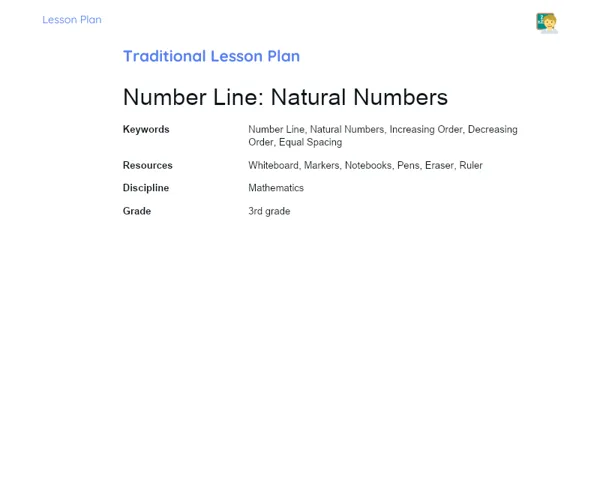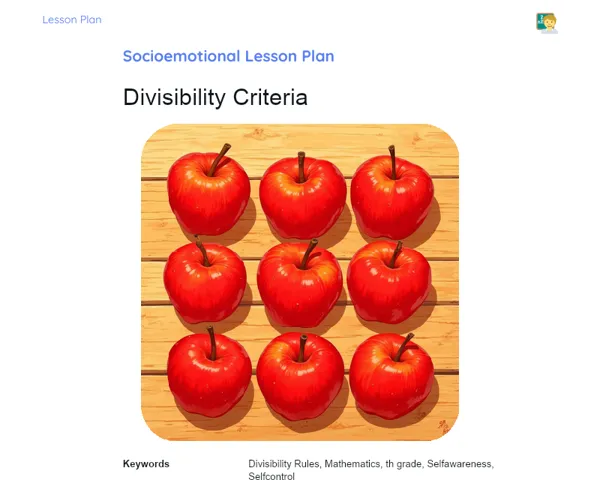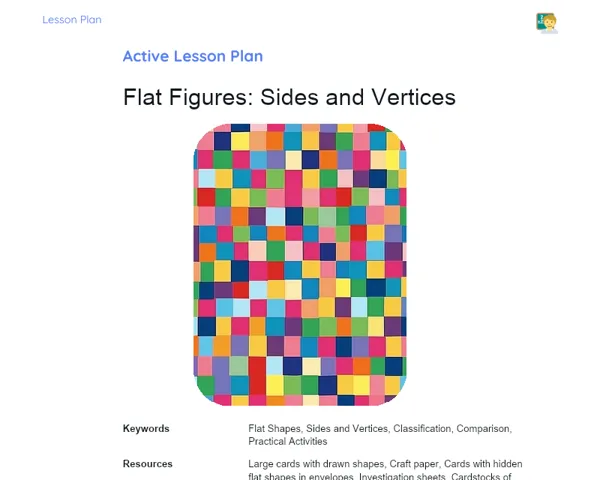Lesson Plan | Lesson Plan Tradisional | Proportion
| Keywords | Proportion, Proportional quantities, Properties of proportions, Direct proportions, Inverse proportions, Problem solving, Everyday context, Student engagement, Practical examples, 7th-grade mathematics |
| Resources | Whiteboard, Markers, Eraser, Projector (optional), Presentation slides, Sheets of paper, Pens, Calculators, Printed tables and graphs, List of practical problems |
Objectives
Duration: (10 - 15 minutes)
The aim of this segment is to ensure that students grasp the fundamental concepts of proportion and their practical uses. By clearly defining the objectives, the teacher establishes a strong base for helping students learn how to solve problems involving proportions and recognise proportional relationships between quantities.
Objectives Utama:
1. Describe what proportion is and its key features.
2. Show how to spot when two quantities are proportional.
3. Use rules of proportionality to tackle real-life problems.
Introduction
Duration: (10 - 15 minutes)
📘 Purpose: This segment seeks to engage students with the lesson theme by demonstrating how relevant proportions are to their daily lives. This sparks interest and motivation to learn, creating a contextual platform to aid in understanding the concepts that will be covered.
Did you know?
🤔 Curiosity: Did you know that the ancient Egyptians used proportions to construct the pyramids? They made sure that all the stone blocks were in proportion to ensure stability. Beyond construction, proportions are used in many fields, like cooking recipes, engineering for bridges and buildings, and even in art to maintain visual balance.
Contextualization
🌍 Context: Kick off the class by asking learners about times they’ve noticed proportions in their daily lives. For instance, point out that the time it takes them to get to school hinges on their walking pace or traffic, which can be seen as a proportion. Ask if they've noticed labels on products that depict mixtures, such as '1 part juice to 3 parts water’. Connect these scenarios to the concept of proportion, stressing that it's a valuable mathematical tool for resolving everyday issues.
Concepts
Duration: (50 - 60 minutes)
📖 Purpose: This stage aims to provide a thorough and practical understanding of proportions, empowering students to apply what they’ve learned in real-world contexts. By systematically covering each topic and solving problems step by step, learners will build essential skills to recognise and address proportionality challenges, reinforcing their mathematical abilities.
Relevant Topics
1. 📏 Definition of Proportion: Explain that a proportion is a relationship between two quantities that shows how many times one quantity fits into the other. Use clear examples, such as comparing the heights of two learners.
2. ⚖️ Properties of Proportions: Discuss the essential properties of proportions, including the basic property (a/b = c/d means ad = bc) and the property of sums (a/b = c/d means (a+b)/b = (c+d)/d).
3. 🔄 Direct and Inverse Proportions: Clarify the difference between direct proportions (when one quantity increases, the other does too) and inverse proportions (when one goes up, the other comes down). Provide relatable examples like the connection between speed and travel time.
4. 🔍 Identifying Proportions: Show how to identify when two quantities are proportional. Use tables and graphs to illustrate how the ratio among constant quantities indicates proportionality.
5. 🛠️ Solving Problems with Proportions: Present relatable problems involving proportions, such as figuring out ingredient quantities in a recipe or calculating distances travelled at a steady speed. Walk through the solutions step by step, explaining each part.
To Reinforce Learning
1. If a cake recipe requires 2 cups of flour for every 3 cups of sugar, how many cups of flour do you need for 9 cups of sugar?
2. A bicycle travels 15 km in an hour. How far will it go in 4 hours at the same speed?
3. If 5 workers complete a wall in 12 hours, how long would it take 8 workers to build the same wall, assuming they all work at the same pace?
Feedback
Duration: (20 - 25 minutes)
📚 Purpose: This segment aims to solidify the knowledge gained during the lesson by allowing students to reflect on the problem-solving process and engage in discussion about their solutions. This dialogue not only strengthens the concepts learned but also fosters engagement and the sharing of ideas, assisting learners in internalising the logic of proportions and using them in practical contexts.
Diskusi Concepts
1. 🗨️ Discussion of Resolved Problems: 2. Cake Recipe: For the cake recipe question, the proportion is 2 cups of flour for every 3 cups of sugar. With 9 cups of sugar, the flour must be adjusted accordingly. The equation becomes: (2/3) = (x/9). Solving gives: x = (2 * 9) / 3 = 6, so 6 cups of flour are needed. 3. Distance Travelled by Bicycle: The bicycle goes 15 km in an hour. To find out how far it travels in 4 hours, we use the direct proportion: (15/1) = (d/4). Solving for d yields: d = 15 * 4 = 60 km. Thus, the bicycle will cover 60 km in 4 hours. 4. Workers Building a Wall: If 5 workers finish the wall in 12 hours, we find out how long it will take 8 workers to do the same by using inverse proportion, as more workers will reduce the time needed: (5/12) = (8/x). Solving for x yields: x = (5 * 12) / 8 = 7.5 hours. Hence, 8 workers will complete the wall in 7.5 hours.
Engaging Students
1. 💬 Student Engagement: 2. Ask learners about any challenges faced during the problems and how they managed to overcome them. 3. Encourage them to articulate their reasoning for the solutions discovered. 4. Prompt them to think of other everyday situations where proportions might apply. 5. Invite students to create their own proportion problems and challenge their peers. 6. Discuss with the class how understanding proportions can aid them beyond school, in things like shopping, cooking, or planning trips.
Conclusion
Duration: (10 - 15 minutes)
The purpose of this stage is to recap the lesson’s main points, reinforce the link between theory and practice, and emphasise the importance of this topic in students' daily lives. This reinforcement aids in solidifying the knowledge gained and inspires learners to utilise what they’ve learned in real-life applications.
Summary
['Overview of what proportion is and its key properties.', 'Understanding the differences between direct and inverse proportions.', 'Identifying proportional quantities using tables and graphs.', 'Resolving practical problems involving proportions, like recipes, travel and construction.']
Connection
The lesson bridged the theory of proportions with practice using everyday examples and real-world problems, such as recipes and travel plans. This approach helped students grasp the practical applications of proportions in their lives, facilitating the understanding of theoretical concepts.
Theme Relevance
Understanding proportions is highly relevant in daily life, as it applies to various scenarios like cooking, shopping, planning trips, and in fields such as engineering. Grasping the concept of proportions enables students to make well-informed decisions and resolve issues efficiently, igniting curiosity about the role of mathematics in diverse aspects of life.



